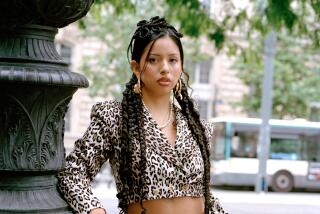Market for Latin Art Takes Off
- Share via
Over the last decade, the country’s leading art auction houses have seen an explosion in Latin American art sales, a testament to the growing internationalism of the art market and increasing knowledge about Latin America and its culture in the U.S.
Both Christie’s and Sotheby’s have seen a jump in sales from a modest $2.5 million at Christie’s and $2 million at Sotheby’s in 1981, to 1998 figures of $19.6 million at Sotheby’s and $21.7 at Christie’s. This increase is concurrent with a surge in galleries and dealers specializing in Latin American art.
On Wednesday in New York, Christie’s will begin its semiannual Latin American art sale, followed a day later by Sotheby’s.
“This is art that spans four centuries and includes 13 countries,” said Ana Sokoloff, Christie’s Latin American Art senior specialist. “The variety and nuances of the work is enormous and it gives a tremendous richness to the market.”
The boom began more than 10 years ago after the publication of a wildly popular biography of Frida Kahlo, said Isabella Hutchinson, director of Sotheby’s Latin American Art department. Hayden Herrera’s 1983 biography of Kahlo ushered in Frida-mania and created a flurry of interest in Mexican art.
“It started a snowball effect,” she said. “I think it got people thinking and interested to learn about it.”
While Herrera’s book planted a seed of curiosity, museums around the United States also were presenting increased exhibitions on Latin American art. One of the first was the Indianapolis Museum of Art, which in 1987 launched its “Art of the Fantastic” exhibition of Latin American works.
Four years later, the popularity and prominence of “Mexico: Splendors of 30 Centuries” exhibition, seen at the Metropolitan Museum of Art in New York, the Los Angeles County Museum of Art and the San Antonio Museum of Art, introduced Americans to the complexity and extent of the history of Mexican art, said August Uribe, Sotheby’s senior vice president and director of fine arts, West Coast.
“These museums were giving shows to art that had been underappreciated and relatively unknown,” he said.
Subsequently, dealers and Latin American art galleries began popping up around the country. They started exploring the contemporary art movements in Argentina, Brazil and Cuba. They found that though each of these countries has experienced political and/or economic turmoil, they have maintained strong artistic societies.
“Cuba has always been a country that produces great artists,” said Teresa Iturralde, whose Los Angeles-based Iturralde gallery specializes in contemporary Latin American art--particularly Cuban works. “But in the ‘80s there was a huge problem with the Cuban government censoring them and not allowing them to travel and show. That has changed, and now they are getting recognized internationally.”
As a secondary market, the auction houses benefited from the increase in activity, both on the contemporary and the Old Master scenes. The peak came in 1994, when Christie’s took in $27.4 million and Sotheby’s $27.8 million.
The Latin American market is highly susceptible to the continent’s economic and political travails, however. The sharp drop in 1994 of the Mexican peso impacted sales in 1995, and last year’s South American financial crisis dented the market last fall.
Nevertheless, prices for some artists’ work have consistently continued to flourish. Indeed, in 1995 Frida Kahlo’s “Self-Portrait With Monkey and Parrot” broke the record for Latin American art when it fetched $3.2 million. A work by her one-time husband, Diego Rivera, was a close second that year, garnering $3 million for his “Dance at Tehuantepec” (the previous record was $2.97 million for a Rivera painting titled “Flower Vendors” in 1991).
“I had never seen anything like it,” said Hutchinson. “All of a sudden you are talking about the art in a totally different dimension. When you have more collectors, you are going to have more people fighting for it and the prices will go up.”
Latin American art is still affordable--relatively speaking. It is still possible to buy a major work by an important Latin American artist, such as that of the Mexicans Rufino Tamayo or Diego Rivera or the Chilean Surrealist Roberto Matta, for under $1 million, which is more difficult with Americans and Europeans of similar stature.
Buying Trends Have Changed
Buyers also have changed. The market has become more international, with Europeans and Americans buying, whereas in the past, primarily Mexicans bought Mexican art, and Argentinians bought Argentine art, for example, said Hutchinson.
Cuban Americans are a particularly strong sector of the buying market, said Hutchinson. Ironically, despite the conflict between Cuban Americans and their native land, there is a growing movement among Cuban American collectors to buy art by Cuban painters from the 1940s, ‘50s and ‘60s, such as Amelia-Pelaez, said Hutchinson.
“There is a very active, healthy art market in Miami,” said Hutchinson. “They are buying that art because it is Cuban and because it is part of their [national] identity.”
The market for contemporary Cuban art is strong, too, said Sokoloff. Cuban artists from 1970 through today, like Jose Bedia, Julio Larraz and sculptor Pepe Rafart are doing well, she said.
“There is a whole series of young artists that promise to arrive soon with a lot of strength,” said Sokoloff, referring to other Cuban artists not yet on the auction block.
At this week’s auction Christie’s is pushing contemporary artists such as Bedia and Brazilian Adriana Varejao, in addition to its “Crucifixion” by Matta (estimated at $400,000-$500,000), Tamayo’s “Man With Birds” ($400,000-$600,000) and Rivera’s “Portrait of Paulette Goddard” ($500,000-$700,000).
It has been a long, hard road for Americans to recognize that Latin American art is not just about folklore and politics, said Sotheby’s Uribe. It is important to understand that its artists have been at the forefront of important artistic movements, he said.
He noted that David Alfaro Siqueiros, one of Mexico’s leading muralists, influenced Jackson Pollock’s work. Joaquin Torres-Garcia, perhaps Uruguay’s greatest modern painter, wrote a letter of introduction in 1915 for an unknown Spanish artist named Joan Miro to meet Pablo Picasso, said Uribe.
“It is still an uphill battle,” said Uribe. “This art has been absolutely underappreciated. It just hasn’t been out there in the mainstream . . . but there is great potential in terms now of the buying side.”
More to Read
The biggest entertainment stories
Get our big stories about Hollywood, film, television, music, arts, culture and more right in your inbox as soon as they publish.
You may occasionally receive promotional content from the Los Angeles Times.










